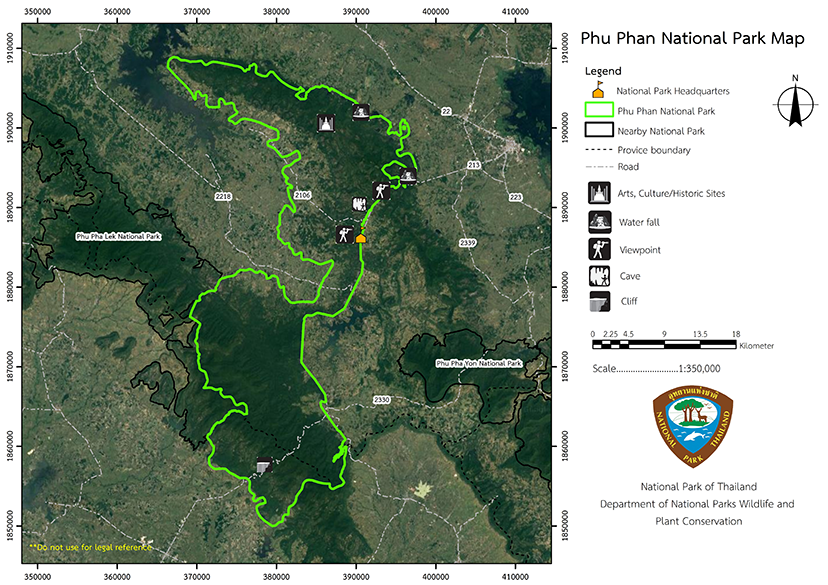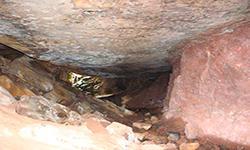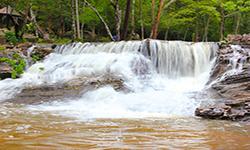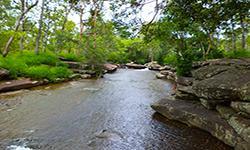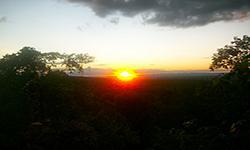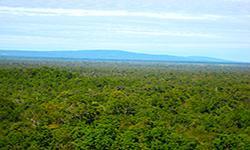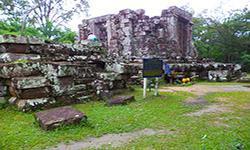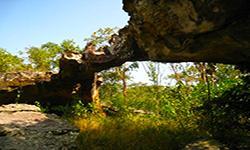Phu Phan National Park
Contact Location : Phu Phan National Park, Huai Yang Sub-district, Mueang Sakon Nakhon District, Sakon Nakhon Province 47000
Telephone Number : (+66) 8 6459 5600, (+66) 8 1263 5029
Email : phuphan2554@hotmail.com
Facebook : Phu Phan National Park
Information
Phu Phan National Park currently covers the areas in Phanna Nikhom, Mueang, Kut Bak and Phu Phan District, Sakon Nakhon Province, Somdet and Huai Phueng District of Kalasin Province and comprises fertile forests and beautiful natural features such as waterfalls, caves, cliffs, and natural scenery. Furthermore, this forest area known as the politically disputed area in the past, during the world war II, it was was a weapon storage area used against Japanese soldiers, therefore, it is a historical site. The area is approximately 415,439 rai, or 664.70 square kilometers.
Background
The Cabinet resolution, dated October 7, 1959, designated Phu Phan Forest, commonly known as "Khao Chom Phu Phan Forest," within the areas of Sakon Nakhon province, Kalasin Province, and other forests within several provinces, a total of 14 forest, to be a national park for permanent protection of natural resources which will benefits the whole. Therefore, the Royal Forest Department has proposed the establishment of Phu Phan Forest as a national park, with the announcement of the Revolutionary Council No. 244 dated November 3, 1972 specifying the area of Phu Phan Forest Land in Na Nai, Rai and Na Hua Bo Sub-district of Phanna Nikhom district, Khok Phu and Namong Sub-district of Kut Bak District, Huai Yang and Phang Khwang Sub-district of Mueang Sakon Nakhon District, Sakon Nakhon Province and Sang Badan Sub-district of Somdet District, Kalasin Province, a total area of 418,125 rai or 669 square kilometers, as a National Park. It was declared in the government Gazette Volume 89, Part 170, dated November 13, 1972. It is the seventh National Park in the country.
Kalasin province issued the document No. Kor Sor. 09/598 dated January 12, 1973, based on the Announcement of the Revolutionary Council No. 244 dated November 3, 1972, stating that in designating Phu Phan Forest to be a National Park, it appeared that the names of some sub-districts of Kalasin Province, which are part of this national park, have not been specified yet. The Royal Forest Department has therefore reinvestigated the national park boundaries. The Royal Decree repealed the announcement of the Revolutionary Council and designated the area of Phu Phan Forest in Na Nai, Rai
and Na Hua Bo Sub-district, Phanna Nikhom District, Phang Khwang and Huai Yang Sub-district, Mueang District, Namong and Khok Phu Sub-district, Kut Bak District, Sakon Nakhon Province, and Saeng Badan Sub-district, Somdet District, Kham Bong Sub-district, Kuchinarai District, Kalasin Province, as a National Park. It was published in the Official Gazette 92 vol, section 106 section, dated June 6, 1975.
The Royal Forest Department conducted a boundary investigation over the Phu Phan National Park area in order to revoke the boundary line of the national park, according to the Cabinet resolution on October 12, 1977 which approved the principle of part of the areas in Bo Hin, no more than five rai. And the National Park Board resolved in the meeting No. 2/2521 on December 12, 1978 assigning the Royal Forest Department to revoke the area of Phu Phan Ratchaniwet Palace, Tham Kham Monastery (Luang Phu Fan) and Huai Khae Reservoir from the Phu Phan National Park area.
However, according to the map at the end of the Royal Decree that designated the Phu Phan Forest Land as a National Park in 1975, some sub-districts were not specified; therefore, the areas could not be revokeed.The Royal Forest Department thus proposed the National Park Board on October 21, 1980 during the meeting no.3/2523 to proceed as the guidelines provided by the Council of State, by proposing a new draft royal decree, putting aside the above areas, and adding the names of the unspecified sub-districts in order to change the national park's boundaries. There is a royal decree that has changed the areas of Phu Phan National Park in Na Nai, Rai and Huai Bo Sub-district, Phanna Nikhom District, Phang Khwang and Huai Yang Sub-district, Mueang District, Namong, Khok Phu and Sang Kho Sub-district, Kut Bak District, Sakon Nakhon Province and Sang Badan, Maha Chai and Pha Sawoei Sub-district, Somdet District, Kham Bong Sub-district, Huai Phueng Minor District, Kuchinarai District, Kalasin Province. It was published in the Official Gazette, Volume 99, Part 161, dated October 29, 1982, the total area is about 415,439 rai or 664.70 square kilometers. (that is, designating additional districts, changing district boundaries and revoking Tham Kham Monastery, Bo Hin, and Phu Phan Ratchaniwet Palace, the Huai Khae Reservoir from the National Park).
Note : After paying the entrance fee to the National Park, please carry the receipt for inspection.
415439.00 rai (664.7024 square kilometers)
|
|
|
||
|
Pricha Suksan Waterfall |
Pha Nang Mern |
||
|
Pha Sawoei |
Phra That Phu Pek |
||
|
|
|||
Nature trails ⇔ Visit Waterfall ⇔ Cave exploration/Geological condition ⇔ Observe flowers/plant ⇔ History/Culture ⇔ Bird/Butterfly ⇔ Camping
Welfare shop : Love Us Save The World Youth Camp (restaurant), is open every day from 8:00 - 16:30 hrs.
Mobile phone signal :
1. National Park Headquarters: AIS, TRUE, DTAC
2. Pha Nang Mern area: AIS, TRUE, DTAC
3. Khamhom Waterfall area: AIS, TRUE, DTAC
4. Preecha Suksan area: AIS, TRUE
5. Serithai Cave area: AIS, TRUE
6. Natural stone bridge area (Ghost Bridge): AIS, TRUE
7. Pha Sawoey area: AIS, TRUE
8. Phra That Phu Pek area: AIS
|
|
Phu Phan National Park is located in the Phu Phan Mountain range. The geological structure is sandstone. At an altitude of 200-567 meters above sea level, it comprises Phu Nang Ngoi, Phu Ma-ngaeo, Phu Noi, Phu Pek, and Phu Khiao which is located within the boundary of Kalasin Proince, is the highest point of the national park, with an altitude of 567 meters above mean sea level. It is the source of headwaters, and streams such as Lao Creek, Aike Creek, Yang Creek, Wiang Phrai Creek, Khi Nok Creek, Khok Creek, Wang Tham Creek, Phueng Creek, I Don Creek, the Upper Nam Un, Sai Creek, Na Chan Creek, which flow into the Un River; Khae Creek, Saen Kong Creek, and the Upper Nam Phong rivers which flow into Pung River; Satot Creek, Kaeng Wa Creek, Kang Khok Creek, and Lak Creek which flow into the Yang Stream; Prik Creek which flows into Lampao; and Sai Creek and Diek Creek which flow into Nong Han.
|
Phu Phan National Park has a cool climate with the lowest temperature in December about 11.5 degrees Celsius, and the average annual temperature of 26.3 degrees Celsius. It can be divided into three seasons: winteris from October to January, summer is from February to April, and the rainy season is from May to September. The average annual rainfall is about 1,353.40 mm.
|
|
|
|
|
The characteristics of Phu Phan National Park forest consists of 3 essential forest types: deciduous dipterocarp forest, mixed deciduous forest, and dry evergreen forest. deciduous dipterocarp forests are found in the central part of the national park up to the northern at 200-400 meters above mean sea level. Essential plants include Burma Sal, Shorea siamensis, Hairy Keruing, Dipterocarpus tuberculatus Roxb, Vitex pinnata, Haldina cordifolia (Roxb.) Ridsdale, Xylia xylocarpa, Simpoh air, Vietnamese mickey mouse plant, Tummy-wood, Parinari anamensis Hance, etc. The undergrowth flora includes Arundinaria pusillia, Ebony, Peach cedar, Cycad, Lavender Wreath, Laurel Clockvine, and etc. Dry evergreen forest are found in large tracts in the south-central part of the national park, and small patches are scattered on the north and south sides at elevation of 400 meters above mean sea level. Essential plants are Velvet Tamarind, Dialium cochinchinense, Castanopsis spp, Dalbergia cultrata, Jambul, Croton oblongifolius Roxb, Artocarpus lacucha Roxb, Markhamia stipulata, Memecylon edule, Mucuna, etc. Most of undergrowth plants are seedlings and saplings of the upper canopyplants , including Calycopteris floribunda Lamk, Velvet Tamarind, Siamese white ixora, Ixora lobbii Loudon, ferns, vines, and etc. Mixed forests are found in the southern part of the National Park. Important plants are Vitex pinnata, Cratoxylum formosum subsp, Copper pod, Xylia xylocarpa, Kenari, Terminalia nigrovenulosa Pierre, Burma Padauk, Ivory, Bungor, etc. Undergrowth plants include Antidesma puncticulatum Miq, bamboo, Alang-alang, vines, etc. Wildlife There are no less than 162 species of wild animals living in Phu Phan National Park, including Wild Elephants, Sambar Deer, Common Barking Deer, Wild Boars, North leaf Monkeys, Sun Bears, Large-spotted Civet, Pig-tailed Monkeys, Lesser Bamboo Rat, Smooth-coated Otter, Indochinese Ground Squirrel, Greater Short-nosed Fruit Bat, Cinnamon Bittern, Serpent-eagle, Chinese Francolin, Greater Coucal, Indochinese Roller, Streak-eared Bulbul, Ashy Drongo, Paddyfield Pipit, Red Junglefowl, Asian Common Toad, Puddle Frog, Dark-sided Frog, Bubble Frog, Spiny-tailed House Gecko, Tokay, Redhead Lizard, Butterfly Lizards, various Skinks, Golden Tree Snake, Common, Painted Bronzeback, Wolf snakes, etc. And in the area of water resources, there are many types of freshwater fish such as minnows, Swamp Barbs, Hard-lipped Barbs, Eye-spot Barbs, Dwarf Snakeheads, Batrachian Walking Catfishes, and Trichopsis species. |
How to get there by car :
From Bangkok, take National Highway No. 1 (Pahon Yothin Road) passing through Saraburi Province. Then take National Highway No. 2 (Mittraphap Road) passing through Nakhon Ratchasima heading for Khonkaen. Continue along National Highway No. 209 (Kaen-Kalasin) and NationalHighway No. 213 (Kalasin - Sakon Nakhon) for about 115 km. The National Park
Headquarters is located along the highway
If coming from Mueang District, Sakon Nakhon Province, go along National Highway No. 213 for about 25 kilometers, passing through the Phu Phan Ratchaniwet Palace, then you will arrive at Phu Phan National Park Headquarters.
- National Park Ranger Station Pho Pho No. 1 (Nong Din Dam)
- National Park Ranger Station Pho Pho No. 2 (Phu Phak Wan)
- National Park Ranger Station Pho Pho No. 3 (Phu Ma-ngaeo)
- National Park Ranger Station Pho Pho No. 4 (Hin Taek)
- National Park Ranger Station Pho Pho No. 5 (Nampung)
- National Park Ranger Station Pho Pho No. 6 (To Keng)
- National Park Ranger Station Pho Pho No. 7 (Cherng Doi)
- National Park Ranger Station Pho Pho No. 8 (Kaeng Mot Daeng)
- National Park Ranger Station Pho Pho No. 9 (Huai Wian Phrai)
- National Park Ranger Station Pho Pho No. 10 (Sang Kho)
- National Park Ranger Station Pho Pho No. 11 (Kang Ka-am)
- National Park Ranger Station Pho Pho No. 12 (Huai Khae)
- Accommodation -Phu Phan 102,103 (Chan Pha 1,2)
- Accommodation -Phu Phan 104 -106 (Phu Phan 4-6)

